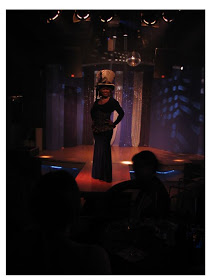The "removals" map. In most cases the things we will be seeing where removed for good, without much replacement. The numbered arrows key to the pix.
 The corner of Fifth and Main. This was all houses, but most on this block were replaced by the Worman-Dye and Canby buildings (shown here) and the Lowe Building (of equal height, which replaced the houses to the far right).
The corner of Fifth and Main. This was all houses, but most on this block were replaced by the Worman-Dye and Canby buildings (shown here) and the Lowe Building (of equal height, which replaced the houses to the far right). The buildings were pretty impressive. 6 or 7 stories in a downtown that was mostly 3 story at the time They survived pretty late, torn down between 1975 and 1980. Replaced by a parking lot, which itself was replaced by the worlds tallest parking garage (not really, though it seems that way). This garage for government workers in the Reibold Building was one of the tallest new buildings to go up downtown, built sometime in the early 2000s.
The buildings were pretty impressive. 6 or 7 stories in a downtown that was mostly 3 story at the time They survived pretty late, torn down between 1975 and 1980. Replaced by a parking lot, which itself was replaced by the worlds tallest parking garage (not really, though it seems that way). This garage for government workers in the Reibold Building was one of the tallest new buildings to go up downtown, built sometime in the early 2000s.
Also on 5th & Main, southeast corner, was the Pruden and Gephardt blocks, examples of downtown extending south during the later 19th century. Both buildings have little turrets or towers, and the Gebhardt tower had a statue on the very top.
 They were torn down in the late 1960s, replaced by the Convention Center, which itself has undergone modernizations and expansions.
They were torn down in the late 1960s, replaced by the Convention Center, which itself has undergone modernizations and expansions. A close up of the Gephardt Block. Again, a quasi gothic facade. This was a theatre or "opera house", which in the last days became the Mayfair Burlesque. Lots of ground floor retail here, and I think there were apartments in the upper floors. One can catch some of the exuberant detailing of the next-door Pruden Block too.
A close up of the Gephardt Block. Again, a quasi gothic facade. This was a theatre or "opera house", which in the last days became the Mayfair Burlesque. Lots of ground floor retail here, and I think there were apartments in the upper floors. One can catch some of the exuberant detailing of the next-door Pruden Block too. The Convention Centers big wastepaper basket entrance is approximatly on the site today. Unintended symbol for a city that's been trashed.
The Convention Centers big wastepaper basket entrance is approximatly on the site today. Unintended symbol for a city that's been trashed.
Climbing into the upper floors of the Worman-Dye Buiding Lutzenberger took this photo of the Barney Block and old Lutheran Church, which became a Scottish Rite temple before being torn down (hence the alley name Temple Lane?). Note between the church and corner building how a surviving house was wrapped in a two story business block. A not uncommon feature in this part of downtown.
 Fifth Street was pretty impressive as a donwtown busy street here, with a wall of three and four story buildings lining the blocks. The Gebhardt Block and tower can be seen at the far right.
Fifth Street was pretty impressive as a donwtown busy street here, with a wall of three and four story buildings lining the blocks. The Gebhardt Block and tower can be seen at the far right.All this was torn down. The proposed downtown shopping mall on this site never materialized. Stouffers, later Crown Plaza, was built instead, dating to the early 1970s. Upper decks of the Transportation Center garage in the background.

Clearing Urban Underbrush.
This image was probably taken from the Fidelity Building, looking over the zone of destruction. Nearly everything you see here is gone. Visible survivors are numbered (you might have click on the image to enlarge to read the numbers)
1. Back of Third Street buildings
2. Delco, later Mendelsons
3. Price Store
4. St Clair Lofts
5. Hauer Music.
The old power plant (by the chimneys) also survived though the chimneys did not.
 Fifth looked like a great city busy street. But it was dying by the late 1950s, dying and dead urban underbrush. A good example of using urban renewal to remove buildings that died an economic death due to suburbanization.
Fifth looked like a great city busy street. But it was dying by the late 1950s, dying and dead urban underbrush. A good example of using urban renewal to remove buildings that died an economic death due to suburbanization. Recall that prior to the 1870s or early 1880s most of what you see here was residential.
Downtown expaneded into this area due to concentration of trade and people via mass transit (on of the first streetcar lines ran downt 5th), which expanded to serve a growning industrial city. A symbiotic relationship existed between economic and population growth and hub & spoke transit systems, resulting in downtown expansion upwards (via skyscrapers) and outwards (like this neighborhood).
When the need to concentrate things went away, so did the economic rasion d'etre for a dense and expanded downtown. So downtown contracted, receded, leaving dead buildings, which were replaced by landscaping, parking, and things that are intermittent uses, like the convention center.









































